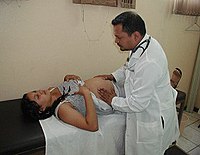
Photo from wikipedia
BackgroundUganda halved its maternal mortality to 343/100,000 live births between 1990 and 2015, but did not meet the Millennium Development Goal 5. Skilled, timely and good quality antenatal (ANC) and… Click to show full abstract
BackgroundUganda halved its maternal mortality to 343/100,000 live births between 1990 and 2015, but did not meet the Millennium Development Goal 5. Skilled, timely and good quality antenatal (ANC) and delivery care can prevent the majority of maternal/newborn deaths and stillbirths. We examine coverage, equity, sector of provision and content of ANC and delivery care between 1991 and 2011.MethodsWe conducted a repeated cross-sectional study using four Uganda Demographic and Health Surveys (1995, 2000, 2006 and 2011).Using the most recent live birth and adjusting for survey sampling, we estimated percentage and absolute number of births with ANC (any and 4+ visits), facility delivery, caesarean sections and complete maternal care. We assessed socio-economic differentials in these indicators by wealth, education, urban/rural residence, and geographic zone on the 1995 and 2011 surveys. We estimated the proportions of ANC and delivery care provided by the public and private (for-profit and not-for-profit) sectors, and compared content of ANC and delivery care between sectors. Statistical significance of differences were evaluated using chi-square tests.ResultsCoverage with any ANC remained high over the study period (> 90% since 2001) but was of insufficient frequency; < 50% of women who received any ANC reported 4+ visits. Facility-based delivery care increased slowly, reaching 58% in 2011. While significant inequalities in coverage by wealth, education, residence and geographic zone remained, coverage improved for all indicators among the lowest socio-economic groups of women over time. The private sector market share declined over time to 14% of ANC and 25% of delivery care in 2011. Only 10% of women with 4+ ANC visits and 13% of women delivering in facilities received all measured care components.ConclusionsThe Ugandan health system had to cope with more than 30,000 additional births annually between 1991 and 2011. The majority of women in Uganda accessed ANC, but this contact did not result in care of sufficient frequency, content, and continuum of care (facility delivery). Providers in both sectors require quality improvements. Achieving universal health coverage and maternal/newborn SDGs in Uganda requires prioritising poor, less educated and rural women despite competing priorities for financial and human resources.
Journal Title: BMC Health Services Research
Year Published: 2018
Link to full text (if available)
Share on Social Media: Sign Up to like & get
recommendations!